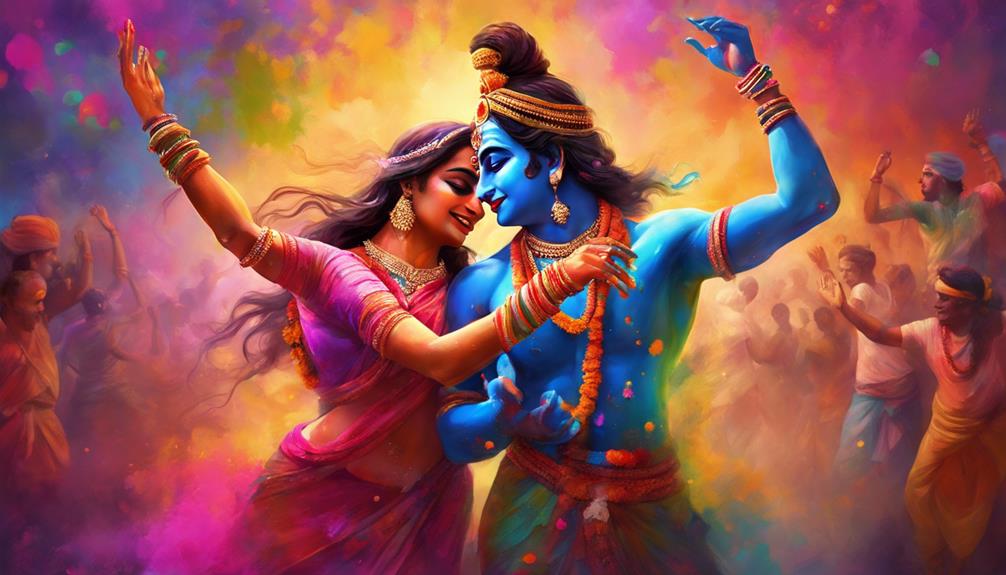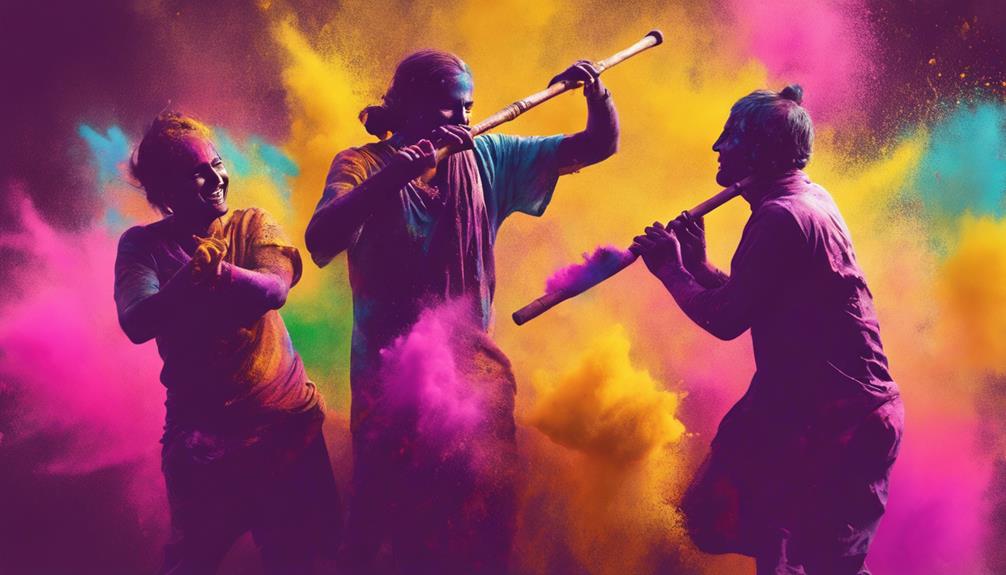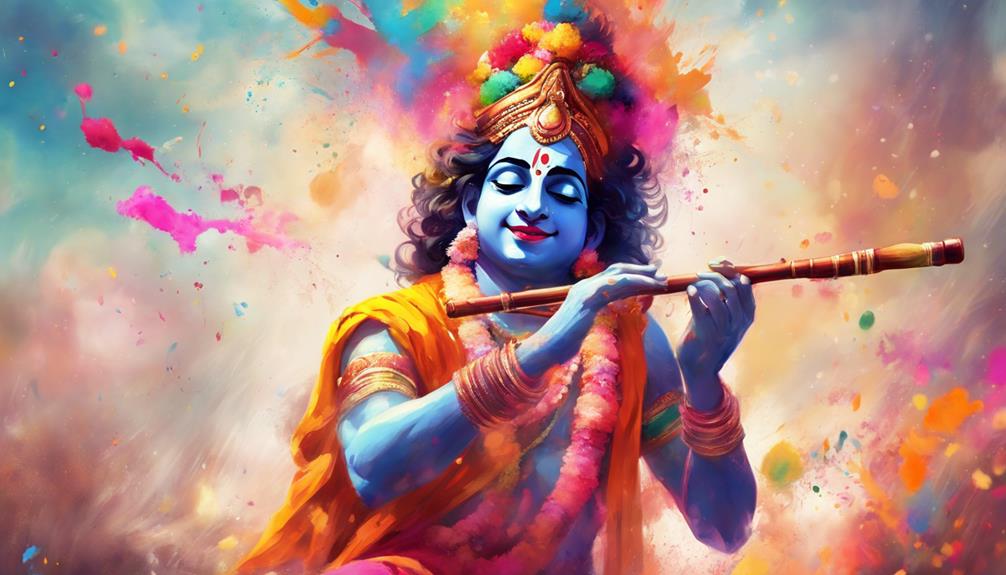Explore the depth of Holi's connection to Lord Krishna as the festival intertwines mythological origins and vibrant cultural traditions. The playful colors of Holi mirror Krishna's joyful spirit, with the festival symbolizing the triumph of good over evil and the arrival of spring. Through Krishna's mischievous pranks, Radha-Krishna's divine love story, and devotional songs and dances, Holi celebrates unity, love, and devotion. The symbolic rituals and legends associated with Holi further illuminate the profound bond between Krishna and the essence of the festival. Uncover the rich tapestry of traditions blending harmoniously with Krishna's divine essence.
Table of Contents
Key Takeaways
- Holi celebrates Lord Krishna's playful pranks with colors.
- Krishna's influence infuses joy, unity, and cultural significance into Holi.
- Colors symbolize love, victory of good over evil, and new beginnings.
- Radha-Krishna's divine love embodies the essence of Holi.
- Krishna's divine nature and teachings of courage resonate in Holi festivities.
Mythological Origins
The mythological origins of the Festival of Holi and its association with Lord Krishna date back to ancient Hindu scriptures and folklore. Krishna's influence on the festival stems from cultural roots deeply embedded in historical significance and festive origins. According to Hindu mythology, Lord Krishna, known for his playful and mischievous nature, popularized the tradition of playing with colors during Holi.
Historically, the festival marks the arrival of spring and the victory of good over evil. It's said that Krishna, as a young boy, would play pranks on the gopis by drenching them in water and colors. This playful act eventually evolved into the joyful celebration of Holi that's observed today.
The colorful and vibrant nature of Holi reflects the joy and exuberance associated with Lord Krishna. The festival serves as a reminder of the power of love, unity, and the triumph of good over evil, making it a cherished tradition among Hindus worldwide.
Significance of Colors
Explore the deep-rooted symbolism of vibrant hues in the festival of Holi, where each color holds a significant meaning that transcends beyond mere aesthetics.
Consider how the joyful expression through colors during this celebration goes beyond the surface level, reflecting a deeper spiritual and cultural significance.
Reflect on the unity that's fostered through the diverse shades coming together, symbolizing the harmony and inclusivity that defines the essence of this colorful festival.
Symbolism of Vibrant Hues
Vibrant hues in the celebration of Holi and the stories of Lord Krishna symbolize a spectrum of emotions and cultural values, creating a rich tapestry of meaning and tradition.
The colors used during Holi have deep-rooted significance beyond mere aesthetics. Each color holds a specific symbolic representation: red for love and fertility, blue for bravery and determination, green for new beginnings and harvest, yellow for knowledge and learning, and pink for joy and playfulness. These colors not only add vibrancy to the festivities but also convey profound messages from mythical lore.
In the context of Lord Krishna, the colors mirror his divine connection and spiritual significance, embodying the essence of his teachings and the joyous spirit of the festival.
Joyful Expression Through Colors
Immerse yourself in the intricate symbolism of the diverse hues that permeate the Festival of Holi and the narratives surrounding Lord Krishna, revealing layers of cultural significance and emotional depth.
Colors play a crucial role in the joyful celebrations, reflecting the spiritual essence and joyous traditions deeply rooted in India's cultural heritage. Each color holds symbolic meaning – red signifies love and fertility, blue represents the divine and infinite, while yellow embodies knowledge and learning.
The act of smearing vibrant colors on one another during Holi transcends mere aesthetics; it signifies the breaking down of social barriers, fostering unity, and spreading cheer. These colorful traditions not only add visual splendor to the festivities but also weave a tapestry of togetherness and shared joy.
Unity in Diverse Shades
Incorporating a rich palette of symbolic colors, the Festival of Holi and the stories of Lord Krishna converge to exemplify unity amidst diverse shades of significance. Holi's vibrant colors symbolize various aspects of life, emotions, and relationships. The festival fosters cultural unity by bringing people together, regardless of social status or background, to celebrate in colorful harmony.
Each color used during Holi holds significance; red represents love and fertility, blue symbolizes the divine and calmness, while green signifies new beginnings and harvest. By smearing these colors on one another, participants embody a sense of togetherness and equality, transcending differences and uniting in joyous celebration.
Through this colorful tradition, Holi and Lord Krishna's narratives emphasize the beauty of unity in diverse shades.
Krishnas Childhood Stories
In the enchanting tales of Krishna's childhood, his playful antics and divine interventions captivate the hearts of all who hear them. Krishna, known for his mischievous nature, would often steal butter from the houses in his village of Vrindavan, earning him the endearing nickname of 'Makhan Chor' or butter thief. His childhood adventures were filled with encounters where he outwitted demons sent by the evil king Kamsa, showcasing his divine powers from a young age.
One of his most famous childhood stories is the tale of him defeating the serpent Kalia in the Yamuna River, saving the villagers and cows from its venomous grasp. Krishna's bravery and compassionate nature shone through even in his early years, as he protected the innocent with his extraordinary abilities. These stories not only entertain but also teach valuable lessons about courage, compassion, and the triumph of good over evil, making Krishna's childhood narratives timeless and revered in Hindu mythology.
Radha-Krishna Connection

The bond between Radha and Krishna in Hindu mythology is a profound and intricate connection that transcends earthly understanding, symbolizing divine love and spiritual union. Radha-Krishna love is often depicted as the epitome of love and devotion in Hindu scriptures and folklore. Radha, a cowherd maiden, represents pure, unconditional love, while Krishna, the charming deity, embodies divine grace and love. Their eternal connection is characterized by mutual adoration, playful interactions, and a spiritual oneness that goes beyond physical boundaries.
The Radha-Krishna relationship is symbolic of the union between the individual soul (Atman) and the divine (Brahman) in Hindu philosophy. Their love story isn't just a romantic tale but a metaphor for the eternal bond between humanity and the divine. The devotion and surrender Radha shows towards Krishna exemplify the ideal relationship between a devotee and the divine. Through their sacred union, Radha and Krishna teach devotees about the power of love, faith, and spiritual connection that transcends time and space. Their eternal love story continues to inspire countless devotees to seek a deeper connection with the divine in their own lives.
Devotional Songs and Dances
Explore the mesmerizing world of devotional songs and dances that captivate hearts and minds during cultural and spiritual celebrations. Traditional dances like the energetic Dandiya Raas and graceful Raslila are performed with intricate footwork and hand movements, narrating tales of Krishna's divine love. Devotional songs, known as bhajans or kirtans, fill the air with melodious tunes praising Lord Krishna's virtues and leelas.
These cultural expressions aren't just performances but avenues for devotees to connect deeply with the spiritual essence of the festival. The rhythmic beats of traditional instruments like the tabla and harmonium set the tone for these celebratory music and dances, creating an immersive experience for participants.
During Holi, these devotional songs and dances take on a special significance, as they symbolize the joyous spirit of the festival and the playful nature of Lord Krishna. The colorful swirls of dancers' outfits and the infectious enthusiasm in their movements mirror the vibrancy and liveliness of the celebrations. Devotees lose themselves in the music and dance, feeling a profound connection to Krishna and the divine energy that permeates the festival.
Symbolism in Rituals

Symbolism intricately woven into the fabric of rituals during cultural and spiritual celebrations reveals profound layers of meaning and significance.
The festival of Holi is rich in ritualistic symbolism, reflecting deeply rooted cultural traditions and spiritual significance. One of the most recognizable aspects of Holi is the throwing of colored powders, known as 'gulal,' which symbolizes the arrival of spring and the vibrant colors of nature awakening after the winter slumber. This act signifies the victory of good over evil, as the colors represent the triumph of light and positivity over darkness and negativity.
Moreover, the tradition of building and lighting bonfires during Holi symbolizes the burning of impurities and the purification of the soul. It serves as a reminder to let go of past grievances and start anew with a cleansed spirit. The intricate rituals of Holi beautifully encapsulate the essence of colorful celebrations and hold profound spiritual significance for participants.
Holi Legends and Krishna
As you explore the legends surrounding Holi and Lord Krishna, you'll uncover the charming tales of Krishna's playful pranks that continue to captivate devotees.
The enduring love story of Radha and Krishna, a central theme in the festival, symbolizes the divine union between soul and spirit.
Additionally, the vibrant colors of Holi hold deep spiritual significance, representing the joyous celebration of triumph over evil and the arrival of spring's renewal.
Krishnas Playful Pranks
In the vibrant tapestry of Holi legends, Lord Krishna's mischievous antics and playful pranks stand out as enduring symbols of joy and camaraderie. Krishna, known for his playful mischief, is often depicted as stealing butter, teasing the gopis (cowherd girls), and engaging in water fights with the villagers of Vrindavan.
One famous tale involves Krishna applying color to Radha's face, sparking the tradition of applying colors during the Holi festival. These playful pranks not only showcase Krishna's lighthearted nature but also symbolize the breaking down of social barriers and the celebration of love and unity. Through his antics, Krishna encourages people to let go of inhibitions and revel in the spirit of togetherness that defines the essence of Holi.
Radha and Krishna
Radha and Krishna's timeless bond epitomizes the essence of love and devotion within the vibrant tapestry of Holi legends. Their relationship symbolizes divine love and an eternal bond that transcends time and space.
Radha, known for her unwavering devotion to Krishna, represents the epitome of selfless love and dedication. Krishna, on the other hand, reciprocates this love with playful yet profound interactions that showcase the depth of their connection.
Their love story is woven into the fabric of Holi celebrations, reminding us of the pure and unconditional love that exists between devotee and deity. Through Radha and Krishna's eternal bond, we learn the significance of surrender, faith, and the transformative power of divine love.
Divine Colors of Holi
Immersing yourself in the vibrant hues of Holi legends intertwined with the essence of Lord Krishna's divine presence brings forth a kaleidoscope of spiritual significance and joyous celebration.
The colorful celebrations of Holi aren't only a feast for the eyes but also hold deep symbolic meaning. The festival's festive traditions of throwing colored powders and water on each other represent the victory of good over evil, as well as the welcoming of spring and new beginnings.
In the context of Lord Krishna, these colors signify his playful and mischievous nature, as well as his ability to spread love and joy among his devotees. The divine colors of Holi serve as a reminder of the joyful and colorful life that Lord Krishna embodies, making the festival a truly enchanting experience.
Krishnas Playful Spirit
With mischievous charm and boundless energy, Lord Krishna's playful spirit captivates all who witness his joyful antics during the festival of Holi. Krishna's mischief and divine playfulness are central to his character, portraying a deity who finds pleasure in playful interactions with others.
During Holi, devotees reenact Krishna's playful nature by engaging in lighthearted activities such as throwing colored powders and water at each other. These acts symbolize Krishna's playfulness and his ability to bring color and joy into people's lives. His mischievous spirit is celebrated through the jovial atmosphere of the festival, where laughter and fun reign supreme.
Krishna's playful spirit also serves as a reminder of the importance of finding joy in the simple things in life. By embodying Krishna's carefree attitude during Holi, participants embrace the idea of letting go of inhibitions and fully immersing themselves in the present moment. Krishna's playful nature thereby inspires individuals to approach life with a sense of lightness and cheerfulness, fostering a deeper connection to the divine through joy and laughter.
Spiritual Teachings of Holi

As you explore the vibrant festivities of Holi, you uncover profound spiritual teachings intertwined within the colorful celebrations. Holi not only signifies the triumph of good over evil but also imparts spiritual insights deeply rooted in cultural traditions. The festive celebrations of Holi remind you of the importance of letting go of past grievances and starting anew, symbolized by the throwing of colored powders. This act represents cleansing the mind and soul from negativity, embracing forgiveness, and fostering unity among people.
Moreover, Holi teaches sacred teachings such as the significance of love and friendship. The tradition of applying colors to one another transcends social barriers, emphasizing equality and camaraderie. It encourages you to see beyond superficial differences and connect on a deeper level with others. Additionally, the joy and merriment during Holi reflect the spiritual principle of living in the present moment and celebrating life's blessings wholeheartedly. Embracing these spiritual teachings of Holi can lead to personal growth, inner peace, and a greater sense of connection with the world around you.
Frequently Asked Questions
How Has the Celebration of Holi Evolved Over Time in Different Regions of India?
As you explore the evolution of Holi celebrations across India, you'll notice diverse cultural adaptations. From region to region, traditional practices have fused with modern influences, creating a vibrant tapestry of festivities that honor this joyous occasion.
Are There Any Specific Foods or Dishes That Are Traditionally Prepared During the Festival of Holi in Honor of Lord Krishna?
During the festival of Holi, traditional recipes hold cultural significance. Dishes like gujiya, mathri, and thandai are prepared to honor Lord Krishna. These foods symbolize love, devotion, and the playful spirit associated with the celebration.
What Are Some Lesser-Known Traditions or Customs Associated With Holi That Are Not Widely Practiced Today?
Discover unique rituals and forgotten customs of Holi. Uncover historical practices and cultural significance not widely known today. Plunge into the rich tapestry of traditions that have shaped this vibrant festival over centuries.
How Do Modern Interpretations of Holi Differ From the Traditional Religious Significance of the Festival in Relation to Lord Krishna?
In modern times, interpretations of Holi often focus on its colorful celebrations and community bonding, moving away from its traditional religious roots tied to Lord Krishna. This evolution reflects changing societal values and the festival's broader appeal.
Are There Any Specific Prayers or Mantras That Devotees Recite During the Festival of Holi to Invoke Lord Krishna's Blessings?
During Holi, devotees chant mantras and offer prayers to seek Lord Krishna's blessings. This spiritual connection is essential in invoking his grace and guidance. By engaging in these rituals, you deepen your bond with the divine.
Conclusion
To sum up, the festival of Holi is deeply intertwined with the stories and teachings of Lord Krishna. From the playful colors to the joyous celebrations, every aspect of Holi reflects the spirit of Krishna.
By honoring this festival, devotees not only commemorate the triumph of good over evil but also connect with the divine love and wisdom embodied by Lord Krishna.
Holi serves as a reminder of the eternal teachings and eternal presence of Krishna in our lives.